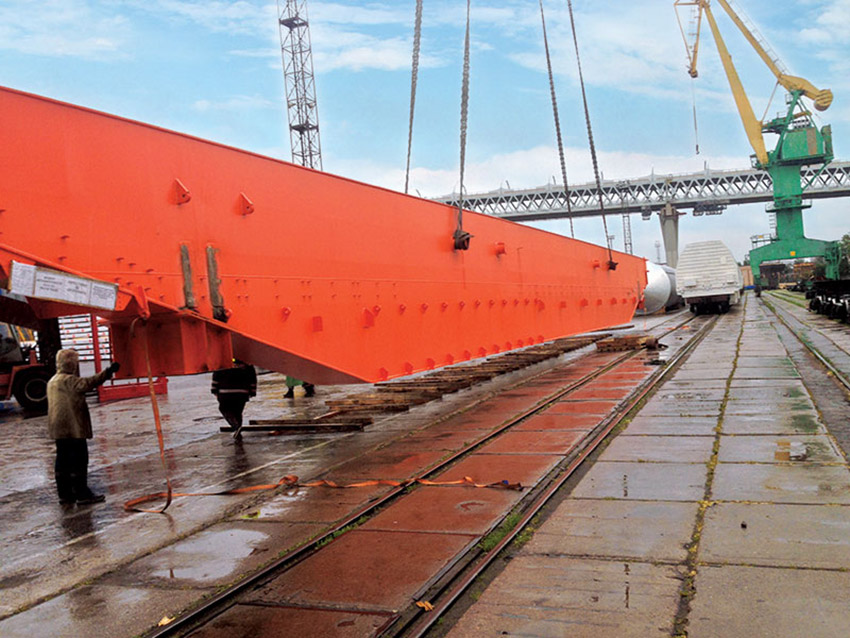Boxco Logistics, along with its consortium partner Deugro, was selected to provide total logistics solutions for setting up Nuclear Power Corporation of India Limited (NPCIL) Kudankulam Nuclear Power Plant Unit III and IV.
The project entails ocean freight from multiple nations and ports in Asia and Europe, inland transportation and handling of Over Dimensional Cargo (ODC) heavy-lift, Overweight Cargo (OWC), general/breakbulk cargo by road and barge; handling, clearing and transporting air cargo and containerized cargo; customs clearance, warehousing and store management, inter-carting, port handling; surveying, designing, modelling, construction and maintenance of jetty, breakwater and other associated structures.
There was barely any time to celebrate, as the notification for the first shipment was received within a few days of the receipt of the purchase order from NPCIL. The preparations for the first shipment got into full swing. The supplier of the equipment, JSC Atomstroyexport (ASE) and their forwarder in the Russian Federation ensured that the cargo reached the port of St. Petersburg from various manufacturing facilities and works in time. The shipment consisted of 687 packages, included 2 girder bridges, each of 42m in length. Due to its delicate nature, the majority of the cargo for the NPP is non-stackable which requires huge vessels with multiple decks. Due to the urgency of the shipments and the costs involved it becomes quite difficult finding the appropriate vessel, keeping in mind the peculiar nature of each different shipment. The vessel selected for the 1st shipment was MV Donald which is a heavy-lift vessel bearing the Liberian flag. The vessel, a part of the United Heavy Lift (UHL) fleet, was equipped with on-board gear having a total handling capacity of 480 MT at 11m.
An administrative office was set up at Kudankulam and Tuticorin, and 53 personnel are deployed to oversee warehousing, handling, preservation, intercarting, and liaisoning with site officials. From Tuticorin Port, the cargo would be moved to the site through barges and via a road route. Equipment, including heavy-duty cranes, forklifts, hydras, hydraulic axles etc., were mobilized to the site and Tuticorin Port from multiple locations. While all this was happening in India, MV Donald had anchored in St. Petersburg to move the first shipment. According to the planned loading sequence and stowage, it took us around 7 days to finish the loading. The loading commenced on time, and then the vessel set sail for Tuticorin with an ETA of 30 days. Cruising at an average speed of around 11 nautical miles/ hour the vessel reached Tuticorin on 22 nd October in a record time of 30 days after passing through the Kiel Canal and the Suez Canal. After a delay of 3 days in berthing due to congestion at port, the ship finally berthed and the unloading commenced in a systematic manner. Owing to the expert planning of our project managers, we were able to cruise smoothly without any hiccups. The discharge was also completed well within the contractual milestone. A combination of trailers consisting of highbed trailers, lowbed trailers, semi-lowbed and hydraulic axles were used to shift the cargo to site within 18 days. Boxco is also undertaking the challenging task of jetty construction at Unit 3 and 4. The jetty would be well-protected by breakwaters totalling more than 1000m, leaving the inner waters calm and easily navigable for tugs and barges. The civil work for the same is being undertaken at break-neck speed to complete the construction much before the scheduled date.

GIRDER BRIDGE BEING HANDLED AT ST. PETERSBURG PORT
As this article is penned, the second vessel MV Xing Fu Song has reached Tuticorin with the second shipment and is in the process of discharging its cargo. The second shipment presented a different set of challenges with its unique type of voluminous cargo.
Since its inception in the early 1980s our Heavy-Lift and Project Cargo Division has contributed, one project a time, to India's growth story and nation building.